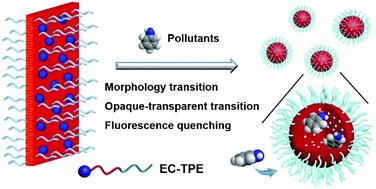当前位置:
X-MOL 学术
›
Polym. Chem.
›
论文详情
Our official English website, www.x-mol.net, welcomes your
feedback! (Note: you will need to create a separate account there.)
Transformable fluorescent nanoparticles (TFNs) of amphiphilic block copolymers for visual detection of aromatic amines in water
Polymer Chemistry ( IF 4.1 ) Pub Date : 2021-08-31 , DOI: 10.1039/d1py00919b Yuhan Cui 1 , Yusheng Zhou 1 , Guodong Liang 1
Polymer Chemistry ( IF 4.1 ) Pub Date : 2021-08-31 , DOI: 10.1039/d1py00919b Yuhan Cui 1 , Yusheng Zhou 1 , Guodong Liang 1
Affiliation

|
A kind of novel transformable fluorescent nanoparticle (TFN) is designed and constructed for the visual and sensitive detection of aromatic amines in water. An amphiphilic diblock copolymer (EC-TPE) bearing a hydrophobic and semicrystalline polycaprolactone (PCL) block, a water-soluble poly(ethylene glycol) (PEG) block, and an endgroup of tetraphenylethene (TPE) chromophore is designed and synthesized. In aqueous solution, the PCL segment crystallizes into large and thin lamellae. The aggregation-induced emission (AIE) chromophore of TPE is pushed out of the lamellae and located on their surface. While the PEG segment forms shells tethered to the surface of the lamellae, endowing the nano-sheets with good stability in water. The polymer (EC-TPE) self-assembles into nano-sheets with a thickness of 20 nm and a lateral size of 2 μm in water, which consist of a crystalline PCL lamella sandwiched between two water-soluble PEG shells with a TPE moiety residing at the interface. Interestingly, the large fluorescent nano-sheets absorb aromatic pollutants in water, and break into small nano-spheres with a diameter of 66 ± 2 nm. Such a morphological transition from large nano-sheets to small nano-spheres is accompanied by an opaque–transparent transition and an efficient fluorescence quenching, which allow the visual detection of organic pollutants in water solutions. The fluorescent nano-sheets enable the sensitive and visual detection of toxic aromatic pollutants at a low concentration with a high Stern–Volmer constant, e.g. 5.1 μg L−1 and 1.7 × 105 M−M, respectively, for aniline. Given multiple response signals, rapid response, and low cost, such TFNs offer an ideal platform for the rapid visual and sensitive detection of organic pollutants in water.
中文翻译:

用于视觉检测水中芳香胺的两亲性嵌段共聚物的可转化荧光纳米粒子 (TFN)
设计并构建了一种新型可转化荧光纳米颗粒(TFN),用于对水中芳香胺的视觉和灵敏检测。设计并合成了一种带有疏水半结晶聚己内酯 (PCL) 嵌段、水溶性聚 (乙二醇) (PEG) 嵌段和四苯基乙烯 (TPE) 发色团端基的两亲性二嵌段共聚物 (EC-TPE)。在水溶液中,PCL 链段结晶成大而薄的薄片。TPE 的聚集诱导发射 (AIE) 发色团被推出薄片并位于其表面。虽然 PEG 片段形成束缚在薄片表面的壳,使纳米片在水中具有良好的稳定性。聚合物(EC-TPE)在水中自组装成厚度为20 nm、横向尺寸为2 μm的纳米片,它由夹在两个水溶性 PEG 壳之间的结晶 PCL 薄片组成,TPE 部分位于界面处。有趣的是,大的荧光纳米片吸收水中的芳香污染物,并分解成直径为 66±2 nm 的小纳米球。这种从大纳米片到小纳米球的形态转变伴随着不透明-透明转变和有效的荧光猝灭,从而可以对水溶液中的有机污染物进行视觉检测。荧光纳米片能够以高 Stern-Volmer 常数对低浓度的有毒芳香污染物进行灵敏和视觉检测,大的荧光纳米片吸收水中的芳香污染物,并分解成直径为 66±2 nm 的小纳米球。这种从大纳米片到小纳米球的形态转变伴随着不透明-透明转变和有效的荧光猝灭,从而可以对水溶液中的有机污染物进行视觉检测。荧光纳米片能够以高 Stern-Volmer 常数对低浓度的有毒芳香污染物进行灵敏和视觉检测,大的荧光纳米片吸收水中的芳香污染物,并分解成直径为 66±2 nm 的小纳米球。这种从大纳米片到小纳米球的形态转变伴随着不透明-透明转变和有效的荧光猝灭,从而可以对水溶液中的有机污染物进行视觉检测。荧光纳米片能够以高 Stern-Volmer 常数对低浓度的有毒芳香污染物进行灵敏和视觉检测,允许目视检测水溶液中的有机污染物。荧光纳米片能够以高 Stern-Volmer 常数对低浓度的有毒芳香污染物进行灵敏和视觉检测,允许目视检测水溶液中的有机污染物。荧光纳米片能够以高 Stern-Volmer 常数对低浓度的有毒芳香污染物进行灵敏和视觉检测,例如,对于苯胺,分别为5.1 μg L -1和1.7 × 10 5 M -M。鉴于多响应信号、快速响应和低成本,此类 TFN 为水中有机污染物的快速视觉和灵敏检测提供了理想的平台。
更新日期:2021-09-14
中文翻译:

用于视觉检测水中芳香胺的两亲性嵌段共聚物的可转化荧光纳米粒子 (TFN)
设计并构建了一种新型可转化荧光纳米颗粒(TFN),用于对水中芳香胺的视觉和灵敏检测。设计并合成了一种带有疏水半结晶聚己内酯 (PCL) 嵌段、水溶性聚 (乙二醇) (PEG) 嵌段和四苯基乙烯 (TPE) 发色团端基的两亲性二嵌段共聚物 (EC-TPE)。在水溶液中,PCL 链段结晶成大而薄的薄片。TPE 的聚集诱导发射 (AIE) 发色团被推出薄片并位于其表面。虽然 PEG 片段形成束缚在薄片表面的壳,使纳米片在水中具有良好的稳定性。聚合物(EC-TPE)在水中自组装成厚度为20 nm、横向尺寸为2 μm的纳米片,它由夹在两个水溶性 PEG 壳之间的结晶 PCL 薄片组成,TPE 部分位于界面处。有趣的是,大的荧光纳米片吸收水中的芳香污染物,并分解成直径为 66±2 nm 的小纳米球。这种从大纳米片到小纳米球的形态转变伴随着不透明-透明转变和有效的荧光猝灭,从而可以对水溶液中的有机污染物进行视觉检测。荧光纳米片能够以高 Stern-Volmer 常数对低浓度的有毒芳香污染物进行灵敏和视觉检测,大的荧光纳米片吸收水中的芳香污染物,并分解成直径为 66±2 nm 的小纳米球。这种从大纳米片到小纳米球的形态转变伴随着不透明-透明转变和有效的荧光猝灭,从而可以对水溶液中的有机污染物进行视觉检测。荧光纳米片能够以高 Stern-Volmer 常数对低浓度的有毒芳香污染物进行灵敏和视觉检测,大的荧光纳米片吸收水中的芳香污染物,并分解成直径为 66±2 nm 的小纳米球。这种从大纳米片到小纳米球的形态转变伴随着不透明-透明转变和有效的荧光猝灭,从而可以对水溶液中的有机污染物进行视觉检测。荧光纳米片能够以高 Stern-Volmer 常数对低浓度的有毒芳香污染物进行灵敏和视觉检测,允许目视检测水溶液中的有机污染物。荧光纳米片能够以高 Stern-Volmer 常数对低浓度的有毒芳香污染物进行灵敏和视觉检测,允许目视检测水溶液中的有机污染物。荧光纳米片能够以高 Stern-Volmer 常数对低浓度的有毒芳香污染物进行灵敏和视觉检测,例如,对于苯胺,分别为5.1 μg L -1和1.7 × 10 5 M -M。鉴于多响应信号、快速响应和低成本,此类 TFN 为水中有机污染物的快速视觉和灵敏检测提供了理想的平台。











































 京公网安备 11010802027423号
京公网安备 11010802027423号